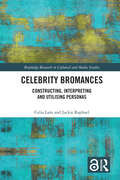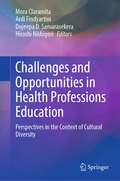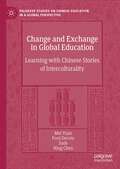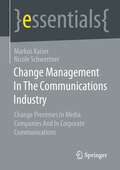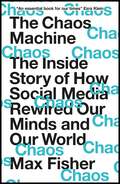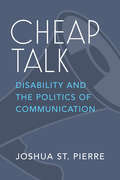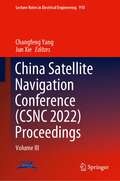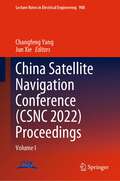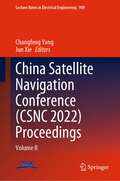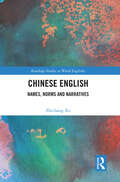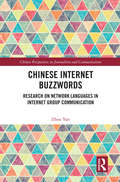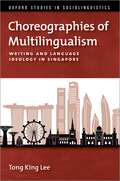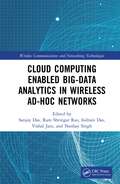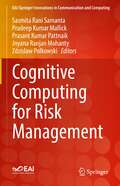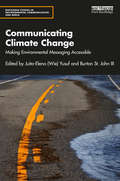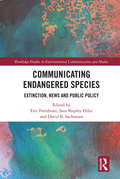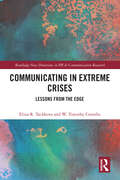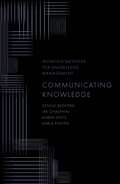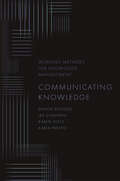- Table View
- List View
Celebrity Bromances: Constructing, Interpreting and Utilising Personas (Routledge Research in Cultural and Media Studies)
by Celia Lam Jackie RaphaelThis comprehensive work presents a thorough exploration of celebrity ‘bromances,’ interrogating how bromances are portrayed in media and consumed by audiences to examine themes of celebrity persona, performativity, and authenticity. The authors examine how the performance of intimate male friendships functions within broadly ‘Western’ celebrity culture from three primary perspectives: construction of persona; interactions with audiences and fans; and commodification. Case studies from film and television are used to illustrate the argument that, regardless of their authenticity (real or staged), bromances are useful for engaging audiences and creating an extension of entertainment beyond the film the actors originally sought to promote. The first truly interdisciplinary study of its kind, this book will be of great interest to scholars and students of communications, advertising, marketing, Internet studies, media, journalism, cultural studies, and film and television.
Challenges and Opportunities in Health Professions Education: Perspectives in the Context of Cultural Diversity
by Mora Claramita Ardi Findyartini Dujeepa D. Samarasekera Hiroshi NishigoriThis book addresses health professions educational challenges specific to non-Western cultures, implementing a shifting paradigm for educating future health professionals towards patient-centered care. While health professions education has received increasing attention in the last three decades, promoting student-centered learning principles pioneered by leaders in the medical community has, for the most part, remain rooted in the Western context. Building from Hofstede’s analysis of the phenomena of cultural dimensions, which underpin the way people build and maintain their relationships with others and influence social, economic, and political well-being across nations, this book demarcates the different cultural dimensions between East and West, applied to medical education. The respective ‘hierarchical’ and ‘collectivist’ cultural dimensions are unpacked in several studies stemming from non-western countries, with the capacity to positively influence healthcare education and services. The book provides new insights for researchers and health professional educators to understand how cultural context influences the input, processes, and output of health professionals’ education. Examples include how cultural context influences the ways in which students respond to teachers, how teachers giving feedback to students, and the challenges of peer feedback and group work. The authors also examine causes for student hesitation in proposing ideas, the pervasive cultural norm of maintaining harmony, the challenges of teamwork in clinical settings, the need to be sensitive to community health needs, the complexity of clinical decision making, and the challenge of how collectivist cultural values play into group dynamics. This book aims to advocate a more culturally-sensitive approach to educating health professionals, and will be relevant to both students and practitioners in numerous areas of public health and medical education.
Change and Exchange in Global Education: Learning with Chinese Stories of Interculturality (Palgrave Studies on Chinese Education in a Global Perspective)
by Mei Yuan Fred Dervin Sude Ning ChenThis unique book starts from the premise that students, scholars, and educators should be given access to a form of global education that is genuinely global. Using the notion of interculturality as change and exchange as a basis, the authors examine fifty discourse instruments (e.g. idioms, neologisms, slogans) related to what they call ‘Chinese stories of interculturality’. China, like other countries, has a rich and complex history of intercultural encounters and her engagement with the notion today, which shares similarities and differences with glocal discourses of interculturality, deserves to be unpacked and familiarized with. By so doing, digging into the intricacies of the Chinese and English languages, the reader is empowered to unthink, rethink and especially reflect on their own take on the important notion of interculturality.
Change Management In The Communications Industry: Change Processes In Media Companies And In Corporate Communications (essentials)
by Markus Kaiser Nicole SchwertnerIn media companies and in corporate communications, digital channels are being added to traditional channels. The content is often produced in newsrooms. There is a growing awareness that communication measures are radically oriented towards the needs of the user. In these change processes, special emphasis must be placed on involving the employees. Because only then will the change process be economically successful. This essential shows why media companies and communication departments need a live change culture and how they can approach change systematically.
The Chaos Machine: The Inside Story of How Social Media Rewired Our Minds and Our World
by Max FisherThe Chaos Machine is an essential book for our times - Ezra KleinThe Chaos Machine is the story of how the world was driven mad by social media. The election of populists like Trump and Bolsonaro; strife and genocide in countries like Myanmar; the rampant spread of COVID-19 conspiracy theories as deadly as the pandemic itself; all of these are products of a breakdown in our social and political lives, a breakdown driven by the apps, companies and algorithms that compete constantly for our attention.Max Fisher is a leading New York Times technology reporter whose work has covered the way that social media sites - driven increasingly by artificial intelligence rather than human ingenuity - push users towards more and more extreme positions, deepening the divisions in society in pursuit of greater engagement and profit. With extraordinary access to the most powerful players in Silicon Valley, and with testimonies from around the world of the havoc being wreaked by our online selves, The Chaos Machine shows us how we got to this uniquely perilous moment - and how we might get out of it.
Cheap Talk: Disability and the Politics of Communication (Corporealities: Discourses Of Disability)
by Joshua St. PierreIn Cheap Talk: Disability and the Politics of Communication, Joshua St. Pierre flips the script on communication disability, positioning the unruly, disabled speaker at the center of analysis to challenge the belief that more communication is unquestionably good. Working with Gilles Deleuze’s suggestion that “[w]e don’t suffer these days from any lack of communication, but rather from all the forces making us say things when we’ve nothing much to say,” St. Pierre brings together the unlikely trio of the dysfluent speaker, the talking head, and the troll to show how speech is made cheap—and produced and repaired within human bodies—to meet the inhuman needs of capital. The book explores how technologies, like social media and the field of speech-language pathology, create smooth sites of contact that are exclusionary for disabled speakers and looks to the political possibilities of disabled voices to “de-face” the power of speech now entwined with capital.
China Satellite Navigation Conference: Volume III (Lecture Notes in Electrical Engineering #910)
by Changfeng Yang Jun XieChina Satellite Navigation Conference (CSNC 2022) Proceedings presents selected research papers from CSNC 2022 held during 25th-27th May, 2022 in Beijing, China. These papers discuss the technologies and applications of the Global Navigation Satellite System (GNSS), and the latest progress made in the China BeiDou System (BDS) especially. They are divided into 10 topics to match the corresponding sessions in CSNC2022 which broadly covered key topics in GNSS. Readers can learn about the BDS and keep abreast of the latest advances in GNSS techniques and applications.
China Satellite Navigation Conference: Volume I (Lecture Notes in Electrical Engineering #908)
by Changfeng Yang Jun XieChina Satellite Navigation Conference (CSNC 2022) Proceedings presents selected research papers from CSNC 2022 held during 25th-27th May, 2022 in Beijing, China. These papers discuss the technologies and applications of the Global Navigation Satellite System (GNSS), and the latest progress made in the China BeiDou System (BDS) especially. They are divided into 10 topics to match the corresponding sessions in CSNC2022 which broadly covered key topics in GNSS. Readers can learn about the BDS and keep abreast of the latest advances in GNSS techniques and applications.
China Satellite Navigation Conference: Volume II (Lecture Notes in Electrical Engineering #909)
by Changfeng Yang Jun XieChina Satellite Navigation Conference (CSNC 2022) Proceedings presents selected research papers from CSNC 2022 held during 22nd-25th May, 2022 in Beijing, China. These papers discuss the technologies and applications of the Global Navigation Satellite System (GNSS), and the latest progress made in the China BeiDou System (BDS) especially. They are divided into 10 topics to match the corresponding sessions in CSNC2022 which broadly covered key topics in GNSS. Readers can learn about the BDS and keep abreast of the latest advances in GNSS techniques and applications.
Chinese English: Names, Norms, and Narratives (Routledge Studies in World Englishes)
by Zhichang XuThis book offers a distinct exploration of Chinese English – which has the largest rising population of speakers in the World Englishes (WE) family. Xu focuses on the fundamental issues of "names" and "norms" that are closely related to Chinese English and the "narratives" of the speakers of Chinese English. In addition to current approaches to WE research, this book proposes a novel theoretical and analytical framework based on classical Chinese and Western philosophies. The volume has an empirical basis, drawing upon interview and questionnaire survey data from proficient speakers of Chinese English. It is also based on an extensive review of the relevant literature on both WE and Chinese English, and it draws upon the author’s research experience of over two decades on the subject. This is the third research book on Chinese English that the author has contributed to WE literature and it will be a valuable read for students and scholars alike.
Chinese English: Names, Norms, and Narratives (Routledge Studies in World Englishes)
by Zhichang XuThis book offers a distinct exploration of Chinese English – which has the largest rising population of speakers in the World Englishes (WE) family. Xu focuses on the fundamental issues of "names" and "norms" that are closely related to Chinese English and the "narratives" of the speakers of Chinese English. In addition to current approaches to WE research, this book proposes a novel theoretical and analytical framework based on classical Chinese and Western philosophies. The volume has an empirical basis, drawing upon interview and questionnaire survey data from proficient speakers of Chinese English. It is also based on an extensive review of the relevant literature on both WE and Chinese English, and it draws upon the author’s research experience of over two decades on the subject. This is the third research book on Chinese English that the author has contributed to WE literature and it will be a valuable read for students and scholars alike.
Chinese Internet Buzzwords: Research on Network Languages in Internet Group Communication (Chinese Perspectives on Journalism and Communication)
by Zhou YanAs the Internet has reshaped the way we communicate, people’s reading has become more fragmented and attention has been directed to a more concise and general form of language that outlines the most important information. This language of the internet, a language system that concentrates on the content of events and public emotions, has emerged and received wide currency. This monograph is one of the first books to examine the language of the internet in the Chinese context. By analysing content and discourse, the author examines Chinese website buzzwords since 2010. She reveals the mechanisms of generation, the cultural nature and political characteristics of the network language, analyzes the causes of its emergence and popularity, and highlights its social and academic significance. Meanwhile, she argues that research in the area is essentially interdisciplinary, involving not only perspectives from Journalism and Communication Studies, but also Philosophy, Culture, Linguistics and Sociology. Students and scholars of Communication Studies and Journalism, as well as Culture Studies should be greatly interested in this title.
Chinese Internet Buzzwords: Research on Network Languages in Internet Group Communication (Chinese Perspectives on Journalism and Communication)
by Zhou YanAs the Internet has reshaped the way we communicate, people’s reading has become more fragmented and attention has been directed to a more concise and general form of language that outlines the most important information. This language of the internet, a language system that concentrates on the content of events and public emotions, has emerged and received wide currency. This monograph is one of the first books to examine the language of the internet in the Chinese context. By analysing content and discourse, the author examines Chinese website buzzwords since 2010. She reveals the mechanisms of generation, the cultural nature and political characteristics of the network language, analyzes the causes of its emergence and popularity, and highlights its social and academic significance. Meanwhile, she argues that research in the area is essentially interdisciplinary, involving not only perspectives from Journalism and Communication Studies, but also Philosophy, Culture, Linguistics and Sociology. Students and scholars of Communication Studies and Journalism, as well as Culture Studies should be greatly interested in this title.
Choreographies of Multilingualism: Writing and Language Ideology in Singapore (OXFORD STUDIES SOCIOLINGUISTICS SERIES)
by Tong King LeeSingapore boasts a complex mix of languages and is therefore a rich site for the study of multilingualism and multilingual society. In particular, writing is a key medium in the production of the nation's multilingual order - one that is often used to organize language relations for public consumption. In Choreographies of Multilingualism, Tong King Lee examines the linguistic landscape of written language in Singapore - from street signage and advertisements, to institutional anthologies and text-based memorabilia, to language primers and social media-based poetry - to reveal the underpinning language ideologies and how those ideologies figure in political tensions. The book analyzes the competing official and grassroots narratives around multilingualism and takes a nuanced approach to discuss the marginalization, celebration, or appropriation of Singlish. Bringing together theoretical perspectives from sociolinguistics, multimodal semiotics, translation, and cultural studies, Lee demonstrates that multilingualism in Singapore is an emergent and evolving construct through which identities and ideologies are negotiated and articulated. Broad-ranging and cross-disciplinary, this book offers a significant contribution to our understanding of language in Singapore, and more broadly to our understanding of multilingualism and the sociolinguistics of writing.
Cloud Computing Enabled Big-Data Analytics in Wireless Ad-hoc Networks (Wireless Communications and Networking Technologies)
by Sanjoy Das Ram Shringar Rao Indrani Das Vishal Jain Nanhay SinghThis book discusses intelligent computing through Internet of Things (IoT) and Big Data in vehicular environments in a single volume. It covers important topics, such as topology-based routing protocols, heterogeneous wireless networks, security risks, software-defined vehicular ad-hoc networks, vehicular delay tolerant networks, and energy harvesting for WSNs using rectenna. Features Covers applications of IoT in Vehicular Ad-hoc Network (VANETs) Discusses use of machine learning and other computing techniques for enhancing performance of networks Explains game theory-based vertical handoffs in heterogeneous wireless networks Examines monitoring and surveillance of vehicles through the vehicular sensor network Investigates theoretical approaches on software-defined VANET The book is aimed at graduate students and academic researchers in the fields of electrical engineering, electronics and communication engineering, computer science, and engineering.
Cloud Computing Enabled Big-Data Analytics in Wireless Ad-hoc Networks (Wireless Communications and Networking Technologies)
by Sanjoy DasThis book discusses intelligent computing through Internet of Things (IoT) and Big Data in vehicular environments in a single volume. It covers important topics, such as topology-based routing protocols, heterogeneous wireless networks, security risks, software-defined vehicular ad-hoc networks, vehicular delay tolerant networks, and energy harvesting for WSNs using rectenna. Features Covers applications of IoT in Vehicular Ad-hoc Network (VANETs) Discusses use of machine learning and other computing techniques for enhancing performance of networks Explains game theory-based vertical handoffs in heterogeneous wireless networks Examines monitoring and surveillance of vehicles through the vehicular sensor network Investigates theoretical approaches on software-defined VANET The book is aimed at graduate students and academic researchers in the fields of electrical engineering, electronics and communication engineering, computer science, and engineering.
Cognitive Computing for Risk Management (EAI/Springer Innovations in Communication and Computing)
by Sasmita Rani Samanta Pradeep Kumar Mallick Prasant Kumar Pattnaik Jnyana Ranjan Mohanty Zdzislaw PolkowskiThis book presents applications of cognitive management and cognitive computing in the fields of risk management, cognitive fraud detection, and in business decision making. The book provides insights on how cognitive management and cognitive computing enable businesses to quickly augment human intelligence and help humans perform tasks better. For example, the authors describe how by analyzing patterns in big data, small data, and "dark data," cognitive technologies can detect human behavior and suggest options for personalizing of products and services. The book studies companies in industries such as automotive, airline, health care, retail, wealth management, and litigation who have adopted these approaches.Presents applications of cognitive computing and cognitive management used in augmenting and empowering business decisions;Shows how to employ the Internet of Things in businesses using a cognitive management framework;Discusses technical aspects and alternatives to traditional tools, algorithms, and methodologies in cognitive computing.
Communicating Climate Change: Making Environmental Messaging Accessible (Routledge Studies in Environmental Communication and Media)
by Juita-Elena Wie Yusuf Burton St. John IIIThis edited collection focuses on theoretical and applied research-based observations concerning how experts, advocates, and institutions make climate change information accessible to different audiences. Communicating Climate Change concentrates on three key elements of climate change communication – access, relevance, and understandability – to provide an overview of how these aspects allow multiple groups of stakeholders to act on climate-related information to build resilience. Featuring contributions from a wide range of scholars from across different disciplines, this book explores a multitude of different scenarios and communication methods, including social media; public opinion surveys; participatory mapping; and video. Overall, climate change communication is addressed from three different perspectives: communicating with the public; communicating for stakeholder engagement; and organizational, institutional, risk, and disaster communication. With each chapter focusing on implications and applications for practice, this book will be of great interest to students and researchers of climate change and environmental communication, as well as practitioners interested in understanding how to better engage stakeholders through climate change-related communication.
Communicating Climate Change: Making Environmental Messaging Accessible (Routledge Studies in Environmental Communication and Media)
by Juita-Elena Wie Yusuf And Burton St. John IIIThis edited collection focuses on theoretical and applied research-based observations concerning how experts, advocates, and institutions make climate change information accessible to different audiences. Communicating Climate Change concentrates on three key elements of climate change communication – access, relevance, and understandability – to provide an overview of how these aspects allow multiple groups of stakeholders to act on climate-related information to build resilience. Featuring contributions from a wide range of scholars from across different disciplines, this book explores a multitude of different scenarios and communication methods, including social media; public opinion surveys; participatory mapping; and video. Overall, climate change communication is addressed from three different perspectives: communicating with the public; communicating for stakeholder engagement; and organizational, institutional, risk, and disaster communication. With each chapter focusing on implications and applications for practice, this book will be of great interest to students and researchers of climate change and environmental communication, as well as practitioners interested in understanding how to better engage stakeholders through climate change-related communication.
Communicating Endangered Species: Extinction, News and Public Policy (Routledge Studies in Environmental Communication and Media)
by Eric Freedman; Sara Shipley Hiles; David B. SachsmanCommunicating Endangered Species: Extinction, News, and Public Policy is a multidisciplinary environmental communication book that takes a distinctive approach by connecting how media and culture depict and explain endangered species with how policymakers and natural resource managers can or do respond to these challenges in practical terms. Extinction isn’t new. However, the pace of extinction is accelerating globally. The International Union for Conservation of Nature classifies more than 26,000 species as threatened. The causes are many, including climate change, overdevelopment, human exploitation, disease, overhunting, habitat destruction, and predators. The willingness and the ability of ordinary people, governments, scientists, nongovernmental organizations, and businesses to slow this deeply disturbing acceleration are uncertain. Meanwhile, researchers around the world are laboring to better understand and communicate the possibility and implications of extinctions and to discover effective tools and public policies to combat the threats to species survival. This book presents a history of news coverage of endangered species around the world, examining how and why journalists and other communicators wrote what they did, how attitudes have changed, and why they have changed. It draws on the latest research by chapter authors who are a mix of social scientists, communication experts, and natural scientists. Each chapter includes a mass media and/or cultural aspect. This book will be essential reading for students, natural resource managers, government officials, environmental activists, and academics interested in conservation and biodiversity, environmental communication and journalism, and public policy.
Communicating Endangered Species: Extinction, News and Public Policy (Routledge Studies in Environmental Communication and Media)
by Eric Freedman Sara Shipley Hiles David B. SachsmanCommunicating Endangered Species: Extinction, News, and Public Policy is a multidisciplinary environmental communication book that takes a distinctive approach by connecting how media and culture depict and explain endangered species with how policymakers and natural resource managers can or do respond to these challenges in practical terms. Extinction isn’t new. However, the pace of extinction is accelerating globally. The International Union for Conservation of Nature classifies more than 26,000 species as threatened. The causes are many, including climate change, overdevelopment, human exploitation, disease, overhunting, habitat destruction, and predators. The willingness and the ability of ordinary people, governments, scientists, nongovernmental organizations, and businesses to slow this deeply disturbing acceleration are uncertain. Meanwhile, researchers around the world are laboring to better understand and communicate the possibility and implications of extinctions and to discover effective tools and public policies to combat the threats to species survival. This book presents a history of news coverage of endangered species around the world, examining how and why journalists and other communicators wrote what they did, how attitudes have changed, and why they have changed. It draws on the latest research by chapter authors who are a mix of social scientists, communication experts, and natural scientists. Each chapter includes a mass media and/or cultural aspect. This book will be essential reading for students, natural resource managers, government officials, environmental activists, and academics interested in conservation and biodiversity, environmental communication and journalism, and public policy.
Communicating in Extreme Crises: Lessons from the Edge (Routledge New Directions in PR & Communication Research)
by Elina Tachkova W. Timothy CoombsThis book is an evidence-based approach to handling common, extreme crises. Extreme crises involve strong moral outrage; moral outrage creates situations where traditional crisis communication advice no longer is effective. These extreme crises create unique demands for crisis managers. Moreover, much of the traditional advice and crisis key performance indicators (KPIs) no longer apply. Validated through research, the book establishes the nature of extreme crises, the optimal crisis response for such crises, and the KPIs (outcomes) crisis managers need to measure for extreme crises. It serves as a guide for how to communicate effectively during extreme crises and provides advice based upon experimental research that validates the effectiveness of the crisis communication interventions. Readers do not require prior knowledge about crisis communication and crisis management as the book contains summaries of crisis communication and management before exploring the more specialized topic of extreme crises. Chapters include extended case studies, examining communication within such events as the Westpac money laundering, VW emissions and COVID-19 crises. Communications in Extreme Crises will be of direct interest to scholars of crisis communication in public relations, corporate communication, strategic communication, organizational communication programs and management.
Communicating in Extreme Crises: Lessons from the Edge (Routledge New Directions in PR & Communication Research)
by Elina Tachkova W. Timothy CoombsThis book is an evidence-based approach to handling common, extreme crises. Extreme crises involve strong moral outrage; moral outrage creates situations where traditional crisis communication advice no longer is effective. These extreme crises create unique demands for crisis managers. Moreover, much of the traditional advice and crisis key performance indicators (KPIs) no longer apply. Validated through research, the book establishes the nature of extreme crises, the optimal crisis response for such crises, and the KPIs (outcomes) crisis managers need to measure for extreme crises. It serves as a guide for how to communicate effectively during extreme crises and provides advice based upon experimental research that validates the effectiveness of the crisis communication interventions. Readers do not require prior knowledge about crisis communication and crisis management as the book contains summaries of crisis communication and management before exploring the more specialized topic of extreme crises. Chapters include extended case studies, examining communication within such events as the Westpac money laundering, VW emissions and COVID-19 crises. Communications in Extreme Crises will be of direct interest to scholars of crisis communication in public relations, corporate communication, strategic communication, organizational communication programs and management.
Communicating Knowledge (Working Methods for Knowledge Management)
by Denise Bedford Ira Chalphin Karen Dietz Karla PhlypoThe communication of knowledge is a core concept in the field of knowledge management and an essential new role and responsibility of business managers. Knowledge capital is the primary source of wealth and the key source of productivity in the knowledge economy. Stockpiling and storing knowledge diminishes its value. It is only through circulation that our knowledge capital realizes its business value. Communicating Knowledge addresses essential management practices in the 21st-century knowledge economy. It speaks to the change that every organization is experiencing as they transition from an industrial to a knowledge organization. The COVID-19 pandemic has heightened an awareness of communications practices in the past year, with communication norms and behaviors being challenged at every level. How we communicate, when we communicate, with whom we communicate, and what we communicate is currently undergoing a global reform. Communication competencies are no longer desirable qualities in managers - they are essential. This book is intended for business managers working at all levels, knowledge management practitioners and scholars, communications professionals, practitioners, and consultants.
Communicating Knowledge (Working Methods for Knowledge Management)
by Denise Bedford Ira Chalphin Karen Dietz Karla PhlypoThe communication of knowledge is a core concept in the field of knowledge management and an essential new role and responsibility of business managers. Knowledge capital is the primary source of wealth and the key source of productivity in the knowledge economy. Stockpiling and storing knowledge diminishes its value. It is only through circulation that our knowledge capital realizes its business value. Communicating Knowledge addresses essential management practices in the 21st-century knowledge economy. It speaks to the change that every organization is experiencing as they transition from an industrial to a knowledge organization. The COVID-19 pandemic has heightened an awareness of communications practices in the past year, with communication norms and behaviors being challenged at every level. How we communicate, when we communicate, with whom we communicate, and what we communicate is currently undergoing a global reform. Communication competencies are no longer desirable qualities in managers - they are essential. This book is intended for business managers working at all levels, knowledge management practitioners and scholars, communications professionals, practitioners, and consultants.
